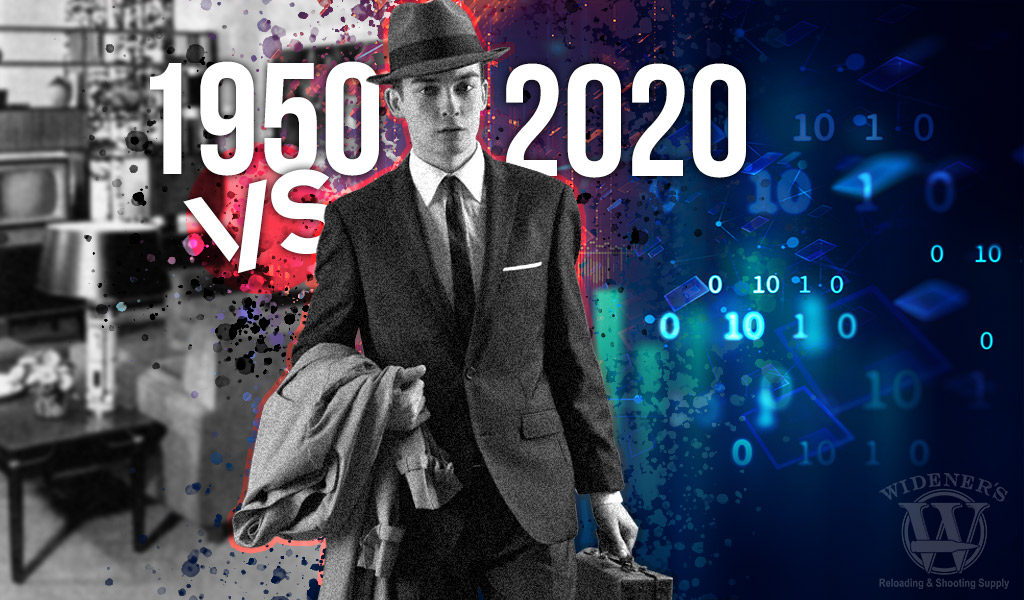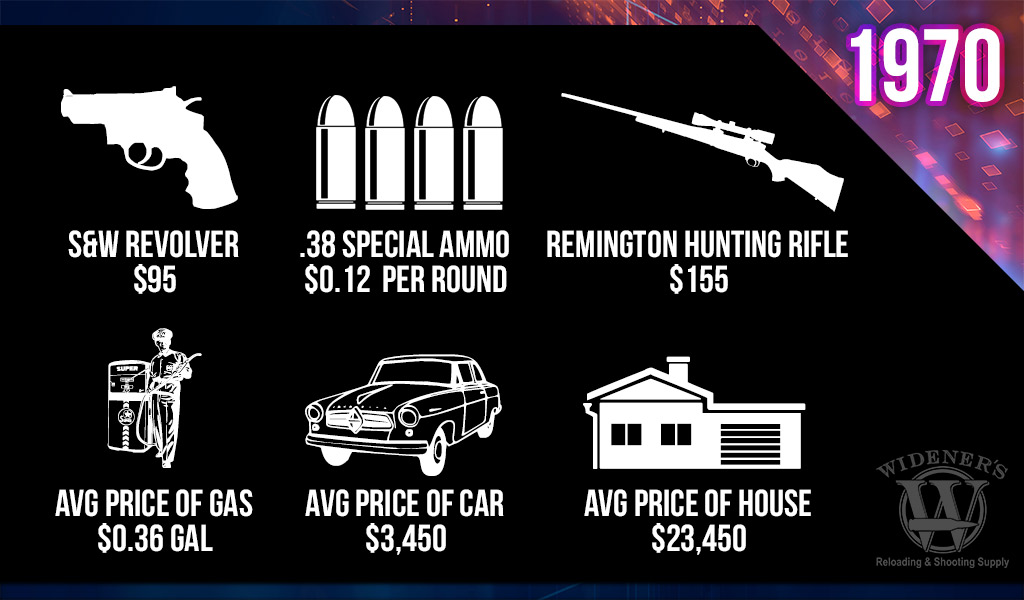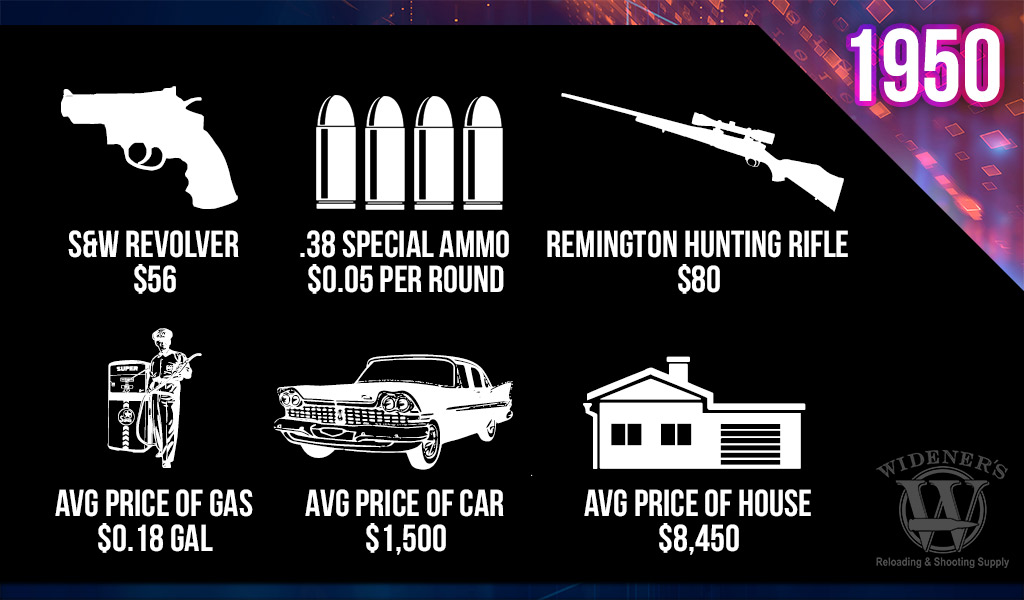

Many Americans old enough to remember the postwar 1950s think of those years with great fondness. After all, these were peaceful times when conformity and uniformity were common, and every family portrayed on television–families in which men worked and women tended the house and children–had smaller problems and plenty of support to get through them.
Jobs were plentiful, and many goods were made in the USA and affordable. Think about this: you could buy a brand-new Ford automobile for around $2,000, and the gasoline that fueled it was $.20 per gallon. The median home value was about $8,000, and you could enjoy a Philco TV in the living room for under $200!
Although much of the culture of the 1950s has been popularized via film and television, many still consider them to be the “Happy Days,” as shown in the popular 1970s sitcom. And many Americans continue to insist that it was also cheaper to live in those good old days. But was it really a more affordable time?
As gun owners, let’s travel through time through the decades to answer the question that has relevance for us: Is it more or less expensive to own guns and buy ammo in 2020 than it was in 1950? The answers might surprise you:
All About The 1970s

The median income of a family in the United States in 1970 was $9,870 after taxes.
Most “Baby Boomers”—those born soon after the end of World War II and into the early 60s—remember 1970 as a year of turbulence. The Vietnam War was raging, and some of those Boomers were fighting while others were at home protesting.
While the college campus protests were garnering much of the attention, many twenty-somethings were living their lives in relative obscurity: working hard during the week and hunting or target-shooting on weekends.
The average family income in 1970 was $9,870. You could buy a house for around $27,000 and a car for $3,900. Gas was $.36 per gallon, but would soon increase dramatically during the 1973 middle-east oil crisis.
The 1970 inflation rate was 5.72% compared to 2.05% today (inflation would peak at a whopping 13.5% in 1980). According to the Bureau of Labor Statistics, today’s prices are 562.91% higher than averages in 1970, and the dollar has undergone an average inflation rate of 3.86% per year during this period.
Think about it: $100 in 1970 is equal to about $662.91 in 2020, in terms of purchasing power. That’s a difference of $562.91 over 50 years!
Popular gun and ammo prices* in 1970:
- Remington 700 Bolt-Action Rifle sold for $154.95 and .308 ammo @ $6.40 per 20 (.32 ea.)
- Colt AR-15 Rifle sold for $234.95 and .223 Rem ammo @ $4.50 per 20 (.22 ea.)
- Browning Shotguns were $244.50 and 12-gauge shells @ $3.50 per 25 (.14 ea.)
- Smith & Wesson .38 Special cost $95.00 and .38 Special ammo @ $6.20 per 50 (.12 ea)
- Colt 1911 .45 ACP Pistol sold for $134.95 and .45 ACP ammo @ $8.75 per 50 (.17 ea.)
The Wild 1960s

The median income of a family in the United States in 1960 was $5,315 after taxes.
It’s hard to imagine any decade containing more change than this one. It all began with a new president: a young and enthusiastic John F. Kennedy replaced the laid-back elder statesman, Dwight D. Eisenhower. But the decade would be defined by a nuclear threat in Cuba, the assassination of the president, an escalating (and mostly unpopular) war, two more assassinations, men on the moon, and those three days of music (and various other activities) called Woodstock.
While the average family income was $9,870 in 1970, ten years earlier, it was $5,600. A house cost $12,700, which was about half the price of 1970. Cars sold for $2,600, compared to $3,900 a decade later, and the price of a gallon of gas was one-third less at $.25.
The inflation rate was 1.72% compared to 5.72% in 1970. Today’s prices are 768.95% higher than average prices in 1960, which means that $100 in 1960 is equal to about $769 of purchasing power in 2020.
Popular gun and ammo prices* in 1960:
- Remington 700 Rifle: $129 with .308 ammo at $5.00 per 20 (.25 ea.)
- Colt AR-15 Rifle: $189 and .223 Rem ammo at $3.60 per 20 (.18 ea)
- Browning Standard Automatic Shotgun: $165 and 12-gauge shells @ $2.85 per 25 (.11 ea.)
- Smith & Wesson .38 Special: $70.00 and the .38 Special ammo @ $4.85 per 50 (.09 ea.)
- Colt 1911 .45 ACP Pistol: $66.75 and the .45 ACP ammo sold @ $5.50 per 50 (.11 ea.)
The Booming 1950s

The median income of a family in the United States in 1950 was $3,210 after taxes.
It’s easy to get sentimental about bygone days when you can recall buying that first car back then for $1,800 or the “home entertainment” TV system for $549.50. Maybe you’ve thought about that Browning A5 12-gauge shotgun that cost you a mere $108. Today, that same gun would set you back over $1500! Doesn’t it make you wish you could return to those affordable times?
Popular gun and ammo prices* in 1950:
- Remington 721 Rifle: $80 with .30-06 ammo at $4.60 per 20 (.23 ea.)
- M1-Garand Rifle: $79.95 and ammo at $3.22 per 20 (.16 ea)
- Browning Standard Automatic Shotgun: $108 and 12-gauge shells @ $2.60 per 25 (.10 ea.)
- Smith & Wesson .38 Special: $56.00 and the .38 Special ammo @ $2.98 per 50 (.05 ea.)
- Colt 1911 .45 ACP Pistol: $49.95 and the .45 ACP ammo sold @ $4.40 per 50 (.08 ea.)
Gun Prices: 1950 VS 2020
Well, before you climb into that time machine, take a peek at the table below to find out the real costs of buying that Browning, along with some other firearms, in 2020.
|
Model of Firearm |
Cost in 1950 |
Cost in 2020 |
1950 Price Adjusted for Inflation |
|
Browning A5 Standard Automatic Shotgun |
$108.00 |
$1,534.00 |
$1,152.00 |
|
Remington 870 Pump Shotgun |
$77.00 |
$847.00 |
$822.00 |
|
Winchester Model 70 Rifle |
$110.00 |
$1,000.00 |
$1,174.00 |
|
Remington 721 Bolt Action Rifle |
$80.00 |
$541.00 |
$854.00 |
|
Colt 1911 .45 ACP Pistol |
$49.95 |
$799.00 |
$531.41 |
|
S&W .38 Special 2″ (Detective Spec) |
$56.00 |
$769.00 |
$598.00 |
The table indicates that the prices of shotguns and pistols have outpaced inflation, and most of the rifles are bargains compared to 1950. But here is something else to consider: the median household income in 1950 was $3,300, while in 2020, it will be $78,900. Putting that into perspective, purchasing the Browning A5 shotgun in 1950 accounted for 3.3% of income. But even though the 2020 price is over 14 times higher than in 1950, buying the shotgun today accounts for only 2% of the median income of American households. Figures for the Colt pistol also reveal 2% of income in 1950 but only about 1% in 2020.
Ammo Prices: 1950 VS 2020
Here are comparisons for the most popular types of ammunition:
|
Ammo Type |
Cost in 1950 |
Cost in 2020 |
1950 Price Adjusted for Inflation |
|
12-Gauge Shells (per 25) |
$2.60 |
$6.99 |
$27.75 |
|
.30-06 180gr (per 20) |
$3.22 |
$14.85 |
$34.50 |
|
.22LR 36gr (per 500) |
$6.50 |
$24.00 |
$69.50 |
|
9mm 115-124gr (per 50) |
$4.09 |
$11.45 |
$43.65 |
|
.38 Special 158gr (per 50) |
$2.98 |
$14.85 |
$31.80 |
|
.45 ACP Ammo 230 gr (per 50) |
$4.40 |
$18.85 |
$46.95 |
Clearly, it is less expensive to buy ammunition today when 1950 prices are adjusted for inflation. Firearms tell much the same story, with a few exceptions. While certain shotguns and pistols appear to be somewhat more expensive in today’s dollars, they take up a smaller percentage of family income in all cases. It could be said that pricing has as much to do with product branding as it does with a product’s longevity on the market.
Draw your own conclusions from the data, but it’s almost a certainty that if you enjoy hunting, target shooting, or collecting firearms, you won’t be dissuaded by these figures! From an investment standpoint, 2020 is a great time to stock up on firearms and ammunition. Widener’s has the best prices on all the ammunition you really want, be sure to visit our website to invest today!
*Pricing for guns and ammo cited in the article was compiled from a variety of period-specific sources including: Guns Magazine, The Shooter’s Bible, The Gun Digest, Remington Sales Catalog, Colt Sales Catalog, and additional periodical source materials. Inflation was calculated using the US Inflation Calculator.


